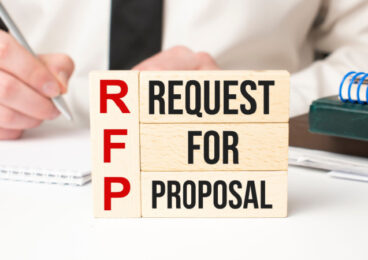 Reading Time: 4 minutes
Reading Time: 4 minutesWhen an organization has a specific need or an availability for a service from another business, the request for proposal (RFP) process is a series of document transfers that essentially allows the organization to solicit bids from various vendors to fill the need. For example, if a company has an upcoming project that requires work from a specialist, the company may send out RFPs to different specialists in the desired field to see if they are interested in the work.
RFP recipients respond to RFPs by filling out the required information for the sender and offering a bid for the work. In some ways, RFPs can help cultivate strong business-to-business relationships, but only when senders craft polite, straightforward, and unobtrusive RFPs.
Many industry leaders in the communication, marketing, and consulting spheres have grown to look at the RFP process with disdain, citing needless complication, potential dilution of brand value, and common administrative delays that seem to overcomplicate what should be a straightforward process. However, most of these issues stem from one simple but universal problem: many organizations simply do not write very good RFPs.
Elements of a Strong RFP
Too many companies fall into a pattern of sending sterile, overly complex, and ultimately annoying RFPs to potential partners. Depending on the structure, tone, and style of an RFP, the recipient may not bother responding at all. In many cases, vendors have simply chosen to stop responding to poor RFPs or RFPs entirely and seek out business-to-business connections through other means. Other companies rely heavily on RFPs for consistent work and must handle RFPs of varying levels of quality. Some smaller companies with unique product and service offerings feel commoditized when larger companies bombard them with RFPs and may receive acquisition proposals more often than requests for specific projects and services.
RFPs don’t need to be a pain point for coordinating services and projects between businesses. Some of the elements of a strong RFP include:
- Multiple easy response options. Don’t make a recipient jump through heaps of red tape just to respond to your request. Offer them a direct line to a representative or whoever will act as the primary contact for the recipient should they decide to work with your company. Avoid boxing them into one type of response format. For example, don’t force vendors to use an online portal for responses or require paper submissions. Offer simple and intuitive digital response options or keep it as simple as providing them with a representative’s email address and phone number.
- While you want to eliminate uncertainty for your RFP recipients, you also want to avoid bombarding them with too much information all at once. Keep your RFP short and to the point, but make sure the RFP answers the most common questions your recipients are likely to have.
- Contact information. Your RFP won’t contain every last detail about the need you’re trying to fill, but it should contain all the contact information and details recipients will need to get in touch with you for more details.
- Open-ended questions. Vendors and service providers generally can’t stand overly complicated questions from RFP senders. Instead of asking for a full rundown of the recipient’s work history, specific figures concerning past projects, or potentially sensitive information they won’t be willing to share anyway, focus on open-ended questions to get a better feel of how the recipient will approach the project if accepted.
You can use many online tools to create a request for proposal example and then experiment to find a winning format for your next project. Many RFP senders will go through multiple rounds of RFPs to narrow down the best potential partners for the job, and this can become tiresome and repetitive if you wind up sending repetitive questions to the same vendors after each wave of RFPs.
Once you look at some of the best SEO RFP and PPC RFP examples, you can see the potential for RFPs to become springboards into cultivating stronger business partnerships. For example, you may send out a first round of RFPs for a project to 20 vendors and receive responses from 12. Take the time to research those 12 vendors and learn what they each have to offer. For the next round of follow-up RFPs, send those 12 vendors more open-ended questions to narrow down your search further. If you take the time to cultivate relationships with other businesses during the RFP process, you can potentially lay the groundwork for fantastic partnerships in the future, regardless of whether a vendor accepts an initial proposal.
RFP Mistakes to Avoid
A few best practices can help you avoid the common RFP mistakes that irritate vendors and complicate supply chain and project management for the companies looking for partners:
- Track your RFPs. If you annoy a vendor with multiple RFPs and repetitive questions, the vendor will probably lose interest and stop responding. Make sure you have a system in place to keep track of the vendors you have already sent RFPs to avoid frustrating them.
- Don’t send to too many vendors at once. If you want to use RFPs to cultivate strong business relationships, don’t spread your team too thin trying to field multiple requests for information and RFP responses from many different vendors all at once. Take time to develop more individualized RFPs for the businesses you plan to contact and then focus on growing those relationships.
- Make sure response information is clear. A potential partner can’t respond to you unless you tell them how to respond, and they likely won’t respond if the system you have in place is clunky, unintuitive, or needlessly complicated.
- Define your objectives clearly. You don’t need to offer any information that you would typically only share with a contracted partner, but you need to give your RFP recipients enough information to see the value in working with you on your proposed project.
- Don’t shy away from negotiation. Once you finish the initial RFP process and narrow your choices down to the last handful of potential partners, don’t expect the vendors you’ve chosen to immediately accept the terms of your contract. Taking the time to engage in respectful and mutually beneficial negotiations with vendors can lay the foundations for very strong professional relationships, so stay flexible and make sure you handle negotiations before choosing a winning bid.
Vizion Interactive can help you craft an RFP sample so you can hopefully avoid many of the common pitfalls facing businesses during the RFP process. We understand the RFP process is an unavoidable and often frustrating element of developing professional relationships but taking the time to develop a solid RFP system can help you establish yourself as a reliable and valuable partner and create lasting professional partnerships for years to come.




